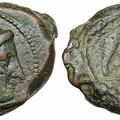Cr. 17/1d Minerva/Horse's head Æ litra, Cosa mint, after 264 B.C.
![Roman Republic Æ litra(5.75g, 18mm), anonymous, after 264 B.C., Cosa mint. Helmeted head of minerva right; border of dots / Horse's head right, on base; behind, ROMA[NO] upwards. Crawford 17/1d; BMCRR Romano-Campanian 12; Sydenham 3a; HN Italy 278
Ex Thersites Collection, Roma e-sale 32 lot 662(provenance incorrectly omitted from lot description), ex Andrew McCabe Collection(flickr timestamp proves pre-Italy MOU provenance), acquired in 2009.
Though this type comes from a very large and well-studied issue, the exact attribution is tricky, and has been heavily debated with many important scholars attributing them to either Rome, Neapolis in Campania, or Cosa in Etruria. I personally follow the attribution that Crawford gives in Coinage and Money Under the Roman Republic (CMRR), in opposition to his earlier Rome mint attribution given in Roman Republican Coinage(the catalog generally referred to as Crawford ), that these were in fact minted at Cosa during the First Punic War as part of Rome's fleet-building efforts.
In CMRR, Crawford argues that Cosa, with its excellent harbour and enclosed lagoons of Orbetello to the north was where Romans built and trained their first fleet and that the Minerva/Horse's head bronzes were struck on that occasion and to meet the expenses connected with that venture (pg. 39). Crawford also points out the stylistically, typologically and metrologically related Mars/Horse's head issues signed COZANO which should obviously be attributed to Cosa as well and further cites find evidence that suggests an area of circulation closer to Rome or Etruria and too far North to fit a Campanian origin.
I am not going to delve far into the alternate arguments here, but for the interested reader I would recommend reading through Cr17.1d.JPG](_data/i/upload/2017/01/20/20170120012201-ef0baeb0-me.jpg)
Roman Republic Æ litra(5.75g, 18mm), anonymous, after 264 B.C., Cosa mint. Helmeted head of minerva right; border of dots / Horse's head right, on base; behind, ROMA[NO] upwards. Crawford 17/1d; BMCRR Romano-Campanian 12; Sydenham 3a; HN Italy 278
Ex Thersites Collection, Roma e-sale 32 lot 662(provenance incorrectly omitted from lot description), ex Andrew McCabe Collection(flickr timestamp proves pre-Italy MOU provenance), acquired in 2009.
Though this type comes from a very large and well-studied issue, the exact attribution is tricky, and has been heavily debated with many important scholars attributing them to either Rome, Neapolis in Campania, or Cosa in Etruria. I personally follow the attribution that Crawford gives in "Coinage and Money Under the Roman Republic"(CMRR), in opposition to his earlier Rome mint attribution given in Roman Republican Coinage(the catalog generally referred to as "Crawford"), that these were in fact minted at Cosa during the First Punic War as part of Rome's fleet-building efforts.
In CMRR, Crawford argues that "Cosa, with its excellent harbour and enclosed lagoons of Orbetello to the north was where Romans built and trained their first fleet and that the Minerva/Horse's head bronzes were struck on that occasion and to meet the expenses connected with that venture"(pg. 39). Crawford also points out the stylistically, typologically and metrologically related Mars/Horse's head issues signed "COZANO" which should obviously be attributed to Cosa as well and further cites find evidence that suggests an area of circulation closer to Rome or Etruria and too far North to fit a Campanian origin.
I am not going to delve far into the alternate arguments here, but for the interested reader I would recommend reading through NAC's "Numismatica Sottovoce"(PDF warning and yes, in Italian, but fairly easy to work through with Google Translate and some patience) in which Russo argues that these Minerva/Horse's head types are, in fact, the smallest denomination of a series of bronze coins that were meant to replace some of the local Campanian small change coinage in the aftermath of the Battle of Beneventum. I mainly reject this argument because the find evidence does not line up with it, and instead suggests that the three types Russo has grouped together are more likely three different types from three different mints, though their areas of circulation may have had some overlap.
This particular example is a very scarce variety of the otherwise common Minerva/Horse's head type in which both Minerva and the Horse's head are facing right. On the vast majority of examples of this type these are facing opposite directions and only on a small fraction of examples are these facing the same direction.

0 comments
Add a comment